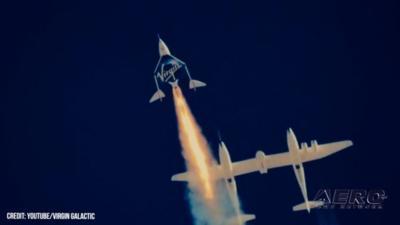Galactic 01 Safely Departs and Returns to Spaceport America
After 19 years, Virgin Galactic, the California-based spaceflight subsidiary of Sir Richard Branson’s Virgin Group, has actualized its founder’s ambition to transport paying passengers to the edge of space... though the short number of actual flights int he test program leaves many questioning the safety of the program.

The historic, 29 June flight saw Virgin Mother-Ship (VMS) Eve, a four-engine, twin-fuselage, twin-empennage behemoth named for Evette Branson, Sir Richard’s mother, lumber skyward from Virgin Galactic’s New Mexico Spaceport America facility at 08:30 MDT.
Slung beneath Eve’s center-wing section, Virgin Space-Ship (VSS) Unity and its complement of three Italian astronauts and two company pilots stalwartly bore the weight of Virgin Galactic’s hopes and the scrutiny of an onlooking world.
Virgin Galactic tweeted: "VSS Unity is currently climbing to release altitude. Our #Galactic01 crew from the @ItalianAirForce & @CNRsocial_, are preparing to conduct 13 scientific research experiments throughout the stages of flight.”
Reaching FL400, Unity separated uneventfully from Eve, dropped free of the massive mother-ship, and fired its hybrid rocket engine.
Accelerating to Mach 2.88, Unity climbed toward space’s edge, reaching its 52.9-mile (279,312-foot) apogee some 58 minutes after Eve lifted off from the Land of Enchantment. For thirteen-minutes, the vehicle drifted at the edge of space while its Italian crew conducted a pre-planned series of scientific experiments.
Unity’s return to Earth was nominal—a term denoting perfection in the argot of spaceflight—culminating in a nicely-executed, 09:42 MDT landing at Spaceport America.
"What a beautiful landing and a perfect way to complete our first commercial flight and our first dedicated science mission. Congratulations to everyone on board," Virgin Galactic's Sirisha Bandla enthused upon Unity’s touchdown.
Branson founded Virgin Galactic in 2004, declaring at the time that the company’s first paying passengers would ascend spaceward by 2007. Fourteen years of delays, setbacks (to include a fatal accident) regulatory woes, federal investigations, and lawsuits ensued. In 2019 the company went public, and has since lost hundreds of millions of dollars while generating only nominal revenue. In the cryptic parlance of finance, the term nominal denotes very, very small.
Success notwithstanding, Virgin Galactic’s characteristically-volatile stock tumbled 11-percent following the 29 June mission.
Caleb Henry, director of research at the space advisory firm Quilty Analytics, remarked: “Branson founded Virgin Galactic almost twenty-years ago. He’s been very patient with trying to see this company through to success. I would say the time is coming where they really do need to deliver on that.”

In addition to investor and consumer uncertainty occasioned by the company’s protracted and difficult gestation, the likelihood of Virgin Galactic’s success is diminished by the company’s narrow focus. Unlike its competitors, which maintain diversified revenue streams the likes of satellite-launch services and ISS cargo supply missions for NASA, Virgin Galactic’s business-model is predicated solely upon suborbital human space-travel.
Virgin Galactic CEO Michael Colglazier remains confident his company’s focus will broaden, but conceded profitability is contingent upon the introduction of Virgin Galactic’s new Delta-class spaceplanes. Optimized, ostensibly, for faster turnaround and easier refurbishment, the Delta vessels are slated to debut in 2025.
Mr. Colglazier posits Virgin Galactic’s customer base will remain small in the short-term, with genuine profitability unlikely until 2026 or 2027.
“I think this is going to be a capacity-constrained business for a couple of decades, at least,” Colglazier opined. “We need to normalize this industry, it’s not usual for your neighbor to go to space.”
 ANN's Daily Aero-Term (05.29.25): Terminal Radar Service Area
ANN's Daily Aero-Term (05.29.25): Terminal Radar Service Area ANN's Daily Aero-Term (05.30.25): Very High Frequency (VHF)
ANN's Daily Aero-Term (05.30.25): Very High Frequency (VHF) Aero-News: Quote of the Day (05.30.25)
Aero-News: Quote of the Day (05.30.25) Airborne 05.23.25: Global 8000, Qatar B747 Accepted, Aviation Merit Badge
Airborne 05.23.25: Global 8000, Qatar B747 Accepted, Aviation Merit Badge ANN's Daily Aero-Linx (05.30.25)
ANN's Daily Aero-Linx (05.30.25)




